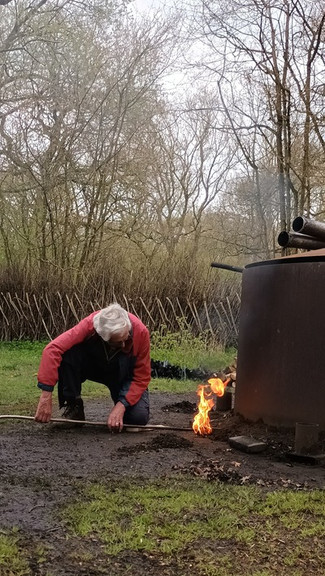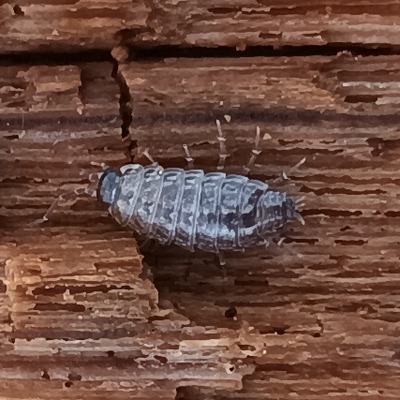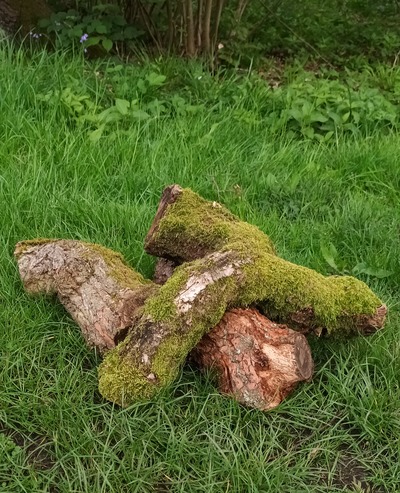Diary from Rawhaw Wood - 2: spring
- Carolyn Church

- May 16, 2023
- 6 min read
Updated: Sep 22, 2023
Carolyn Church

Carolyn Church continues her picture diary from the coppiced hazel woodland in Rockingham Forest. In her previous blog article you can read about what life was like in the winter.
21st March 2023

We have just finished coppicing for the season and next we have some planting to do.
We are increasing the density of the Hazel stools to roughly two metre spacings, this encourages the regrowth to compete with its neighbouring stools and grow straight up towards the sunlight.
Here Keith and I are planting new Hazel.
Using the waste materials (brash) to form the dead hedges around the compartment means that the ground is cleared and makes it easy to see where new plants need to be placed.

This photo shows lichen growing on a Hazel branch. Lichens are unusual in that they are made up of two different organisms living in partnership, a fungus and an alga.
The fungus provides the body in which the alga can live, protecting it from harmful levels of light and helping to prevent it drying out in times of drought. In return the alga can produce simple sugars through photosynthesis to feed the fungi.
Lichens were some of the earliest life forms to move onto the land.
23rd March 2023
After clearing the understorey in the coppice coup we then look at the overstorey, the large Oaks and Ash trees. We are looking to reduce the overall shading in the compartment to around 25-30%, allowing enough light to reach the woodland floor so that the ground flora and the coppice regrowth can thrive.

These photos show tree-surgeons Ross and Kev at work on an Oak tree.

In the early years of our restoration of the wood, we had to have a number of the Oak trees completely felled because the high canopy cover was far to dense, now we can keep light levels open by raising the canopy of the remaining large trees without having to fell them.

This photo shows me standing at the base of one of the Oak trees. Some of the lower branches have been removed so that enough light will reach the woodland floor.
5 April 2023
Our final job at the end of the coppicing season is to finish off the exclosure of the coppiced coupe. We never have quite enough brash to build the dead hedging all of the way around the compartment, so the last section is secured using either post and wire or chestnut paling fencing. The photo shows the extent of last winters coppicing.

7th April 2023

Hawthorn shield bug on a fence post.
After hibernating over the winter this Hawthorn shield bug has emerged into the spring sunshine, at this time of year he or she is on the lookout for a mate. Eggs are laid in the spring and then during the summer months the nymphs feed on the ripening berries of Hawthorn, Rowan or Whitebeam trees. Here in Rawhaw Wood it's Hawthorn berries and the adult bugs feed on the Hawthorn leaves.

11th April 2023
This photo shows 7ft Hazel poles waiting to be collected by a customer.
They are leaning against a pile of mixed species timber cut from the coppice over winter, this wood will be converted into charcoal through the summer months. At this time of year our roles change completely, we cease to be coppice workers and become charcoal burners.
18th April 2023
Having dusted off the machinery after its winter break and checked oil, recharged batteries, inflated tyres, etc, we are ready to start sawing and splitting the wood for the first charcoal burn of the year. The timber is loaded onto the trailer and taken to the charcoal kiln and tipped.
As the wood is a site of special scientific interest (SSSI), when we first started making charcoal here nearly thirty years ago now, Natural England or English Nature, as they were called back then, requested that we confine our charcoal burning to one area, so rather than moving the kiln around the wood we bring the wood to the kiln.

10th April 2023
Jemma and myself starting to load the kiln for the first charcoal burn of the season.
21st April 2023
Early spring in a coppice woodland is a magical time, in the newly coppiced areas an abundance of spring flowers appear taking advantage of the warm sunshine that can reach the woodland floor.
The first photo shows a carpet of wood anemones in an area coppiced during the winter of 2021-2022. There are celandines, violets, and primroses flowering as well.

Here is a Large or Dark-edged Bee-fly taking advantage of the nectar produced by the early flowering woodland plants.
The fly's mimicry of a bumblebee is used as a disguise to allow it to get close to solitary bee and wasp nests in order to lay its eggs nearby. After hatching the fly's larvae enter the bee or wasp nest where they parasitise the grubs of the host bees or wasps, slowly consuming them. Eventually they becoming a pupa and overwinter, ready to emerge in the following spring.
26th April 2023
Charcoal-making is a summer-time activity for us but today Hugh lit the charcoal kiln for the first time. We made a fire site at the base of the kiln before carefully stacking the wood to be charcoaled on top. It takes about an hour before the kiln gets up to temperature at which point we can drop the lid into place sealing it with sand, and put the chimneys in position. The kiln then burned for around twenty four hours before it could be put out and allowed to cool.
The third picture was taken a few days later and shows Hugh inside the charcoal kiln shovelling charcoal onto the riddle, where it is sorted, graded and then bagged. I'll go into a lot more detail about the charcoal-making process during the summer time.
29th April 2023
The peacocks are looking very splendid at the moment with their display feathers at their finest. They moult the whole tail in July at the end of the breeding season and then regrow the feathers again through the autumn and winter.
And just to prove it's not all in vain the third picture shows a peahen nest with five eggs. This is a vulnerable time for the peahen as she incubates the eggs on the ground for almost a month and is susceptible to attack by predators.
Ps As of the 11th May the peahen was OK and still sitting on her eggs.
5 May 2023

A dead standing Oak tree.
We leave as much dead standing timber as we can as it is a wonderful habitat for a variety of birds and invertebrates. As you can see from the photograph a large strip of bark has fallen from the trunk and over few days I recorded some of the larger and slower moving beasties living under the decaying wood. There were many other smaller and faster moving creatures that evaded the camera!
Firstly here's a Pill Millipede, rolled up and moving around. They feed on decomposing plant material usually in woodlands.
Then there are two more kinds of millipede.
The local Wildlife Trust were running a course on millipedes and centipedes earlier this year, I wish I'd booked a place now!
I think as a general rule, millipedes have two pairs of legs per body segment and centipedes have one pair per body segment.

The Brown Centipede, or the right, can live a surprisingly long time up to five or six years. They are predators feeding mainly on insects, spiders, slugs and worms and use venom in their front legs to overpower their prey.
Below are two types of woodlouse. The Common Striped or Fast Woodlouse is on the left and the Common woodlouse on the right. The pale patches its back are areas of stored calcium, which is used to reinforce the exoskeleton after a moult.
Finally there were several types of slugs and snails.
It's so important to leave dead wood when managing woodland for wildlife.
7 May 2023
It's always nice to find a Toad and we often do. The Common Toad can live for up to twelve years and their diet includes, woodlice, slugs, snails, beetles and earthworms so the fallen bark of the oak tree has created the equivalent of a fast food outlet for this fellow. Having a few logs in a pile in the corner of your garden can also create a haven for small creatures like this and can also make an interesting feature.

10 May 2023
As Rawhaw Wood is a SSSI (Site of Special Scientific Interest), we are monitored by Natural England.
During their site assessment visit, John and three of his colleagues conducted a woodland survey, and we had a chance to show them the results of our work carried out over the last twelve months.
We have always enjoyed a good working relationship with Natural England and they have been very supportive over the years.
There will be more from Carolyn's diary next month, as spring becomes summer.
Hugh and Carolyn are partners in the Building the Links for Rockingham Forest project. You can find out more about their Hazel Woodland Products here. It is possible to visit the wood and sign up for their training courses later in 2023.


















































Comments